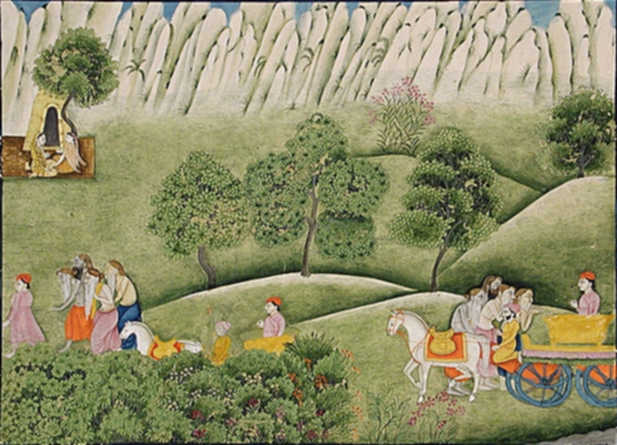The king’s painting of Shakuntala Explain its relevance
In Kalidasa's play "Abhijnana Shakuntalam" (The
Recognition of Shakuntala), the king's painting of Shakuntala serves as a
symbol of his love and commitment to her. The painting is made by the king,
Dushyanta, after he falls in love with Shakuntala and promises to marry her.
The painting serves as a reminder of the love and commitment he feels for her
and represents his desire to keep her with him forever.
The painting also serves as a symbol of the power of memory
and art. The painting serves as a reminder of the king's past with Shakuntala
and it is through the painting that the king is able to recognize her and
remember their past together. The painting also shows the king's artistic
abilities and his ability to capture the beauty and essence of Shakuntala.
Furthermore, the painting also serves as a reminder of the
king's responsibilities towards Shakuntala, it serves as a reminder of his
promise to marry her and his duty to take care of her. The painting also serves
as a reminder of the king's guilt and shame when he denies knowing Shakuntala.
Overall, the painting in "Abhijnana Shakuntalam"
serves as a reminder of the king's love for Shakuntala, his responsibilities
towards her and his ability to remember and capture their past together.
What is the importance of Shakuntala
In Kalidasa's play "Abhijnana Shakuntalam" (The
Recognition of Shakuntala), Shakuntala is the central character and her story
serves as the basis for the play's plot and themes. Shakuntala is a young woman
who lives in the forest with her friends and is visited by King Dushyanta. They
fall in love and he promises to marry her but he forgets about her after
leaving the forest. Shakuntala gives birth to a son and raises him in the
forest.
The character of Shakuntala is important for several reasons:
- She represents the power of love and desire: Shakuntala's love for Dushyanta and her desire to be with him drive the plot of the play and demonstrate the power of love to overcome obstacles.
- She represents the struggle of women: Shakuntala is a woman who is abandoned by her lover and forced to raise her child alone, she represents the struggles and challenges that women face in patriarchal societies.
- She represents the power of nature: Shakuntala lives in the forest with her friends and is connected to nature, she represents the power of nature to heal and provide solace.
- She represents the power of motherhood: Shakuntala raises her son alone, she represents the strength and resilience of motherhood and the importance of the mother-child bond.
- She is the representation of the theme of memory and recognition: Shakuntala's story is about the power of memory and recognition and the role it plays in resolving conflicts and restoring relationships.
Shakuntala is an important character in the play as she
represents the various themes and motifs that Kalidasa explores in
"Abhijnana Shakuntalam".
What type of painting is Shakuntala
In Kalidasa's play "Abhijnana Shakuntalam" (The
Recognition of Shakuntala), there is no detailed description of the type of
painting of Shakuntala. It is mentioned that the King Dushyanta paints
Shakuntala which serves as a symbol of his love and commitment to her. It is
not specified what type of painting it is, whether it is a portrait, a
miniature painting or any other kind of painting.
It is important to note that the play is a work of
literature, and not an historical document, so the painting is used as a
literary device to add symbolism and depth to the story. The painting serves as
a reminder of the king's love for Shakuntala, his responsibilities towards her
and his ability to remember and capture their past together.
What would help the king remember Shakuntala
In Kalidasa's play "Abhijnana Shakuntalam" (The
Recognition of Shakuntala), King Dushyanta forgets about Shakuntala after
leaving the forest. However, there are several things that could have helped
him remember her:
- A physical reminder: A physical object such as a ring or a painting of Shakuntala could have served as a reminder of his love for her and their time together in the forest.
- A token of love: Something that the king had given to Shakuntala, such as a flower or a piece of jewelry, could have helped jog his memory and reminded him of their relationship.
- A letter or a message: A letter or a message from Shakuntala could have reminded him of her and their love, and helped him remember her.
- A promise: If the King had made a promise to Shakuntala, such as marriage, it would have served as a reminder of his commitment to her.
- A dream: Sometimes, a dream or a vision could help to jog someone's memory. If the king had dreamt of Shakuntala, it could have helped him remember her.
In the play, the recognition of Shakuntala is brought about
by the discovery of a ring that Dushyanta had given to Shakuntala, and that she
had worn as a token of their love. The ring serves as a physical reminder and
it helps Dushyanta to remember Shakuntala, and recognize her as his wife.
How would you describe Shakuntala
In Kalidasa's play "Abhijnana Shakuntalam" (The
Recognition of Shakuntala), Shakuntala is the central character and can be
described in several ways:
- Strong-willed and determined: Shakuntala is a young woman who is determined to find her place in the world and to be recognized by her lover, King Dushyanta.
- Kind-hearted and compassionate: Shakuntala is a kind-hearted and compassionate person, she cares for her friends and is devoted to her son.
- Connected to nature: Shakuntala lives in the forest with her friends and is connected to nature, she represents the power of nature to heal and provide solace.
- Resilient and resourceful: Shakuntala is a woman who is abandoned by her lover and forced to raise her child alone, she demonstrates resilience and resourcefulness in the face of adversity.
- A representation of love and desire: Shakuntala's love for Dushyanta and her desire to be with him drive the plot of the play and demonstrate the power of love to overcome obstacles.
- A representation of the struggles of women: Shakuntala represents the struggles and challenges that women face in patriarchal societies.
- A representation of motherhood: Shakuntala raises her son alone, she represents the strength and resilience of motherhood and the importance of the mother-child bond.
- A representation of the theme of memory and recognition: Shakuntala's story is about the power of memory and recognition and the role it plays in resolving conflicts and restoring relationships.
Overall, Shakuntala is a multi-faceted character in the play
and she represents various themes and motifs that Kalidasa explores in
"Abhijnana Shakuntalam".
ALSO READ:-
Explain the dramatic function of the ring in Abhijnana Shakuntalam
What are the critical views of John Dryden, Alexander Pope and Samuel Johnson
Discuss how Charles Darwin’s idea of evolution inspired a new wave a thought
WHATSAPP:- 8130208920
YOUTUBE:- MYEXAMSOLUTION








0 comments:
Note: Only a member of this blog may post a comment.